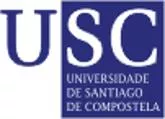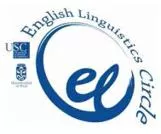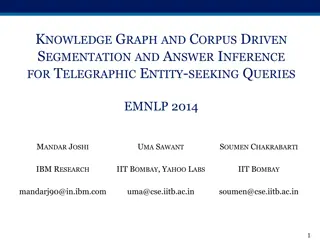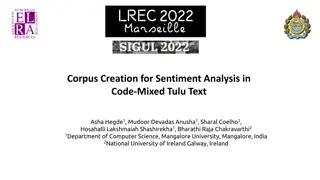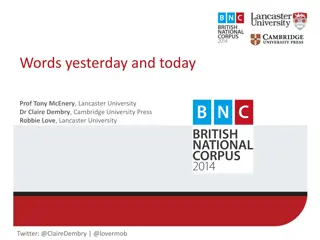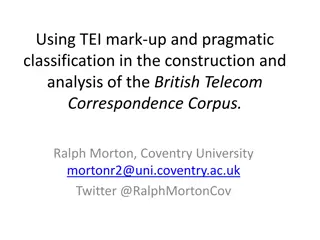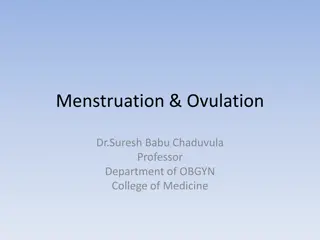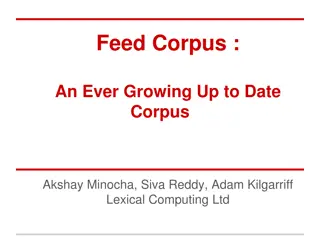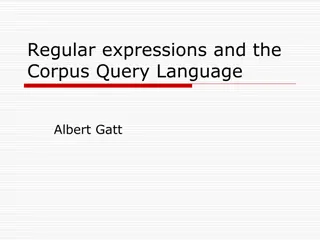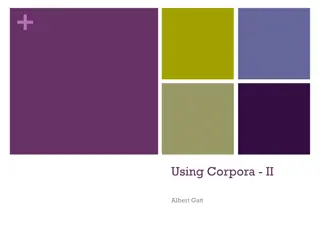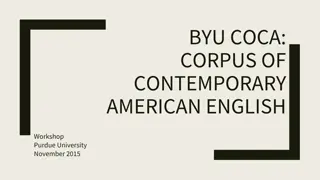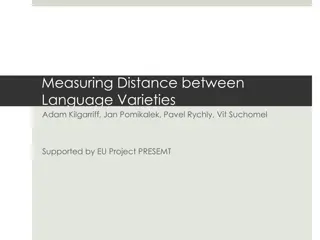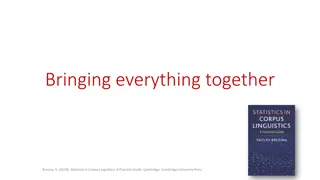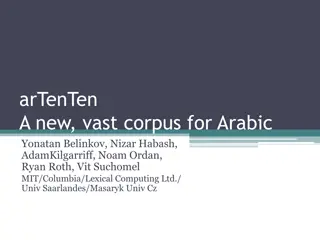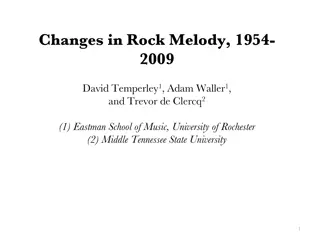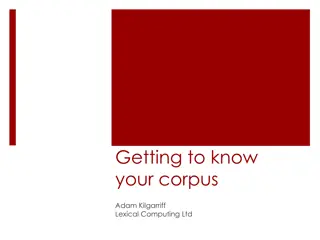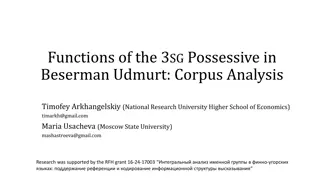The CAES Corpus Project Overview
The CAES Corpus Project involves a computerized corpus of Spanish as a foreign language, financed by the Cervantes Institute and carried out by a research team from the University of Santiago. Learn about its origins, development, features, and participant demographics.
Download Presentation

Please find below an Image/Link to download the presentation.
The content on the website is provided AS IS for your information and personal use only. It may not be sold, licensed, or shared on other websites without obtaining consent from the author.If you encounter any issues during the download, it is possible that the publisher has removed the file from their server.
You are allowed to download the files provided on this website for personal or commercial use, subject to the condition that they are used lawfully. All files are the property of their respective owners.
The content on the website is provided AS IS for your information and personal use only. It may not be sold, licensed, or shared on other websites without obtaining consent from the author.
E N D
Presentation Transcript
LEARNER THE CAES CORPUS DE APRENDICES DE ESPA OL PROJECT SPANISH ON COMPUTER. IGNACIO M. PALACIOS MART NEZ DEPARTAMENTO DE FILOLOG A INGLESA Y ALEMANA UNIVERSIDADE DE SANTIAGO DE COMPOSTELA
The CAES Project This presentation will be organised in two parts : The first part will be dealing with the origin, development and description of the project. The second will be concerned with a study derived from the analysis of data extracted from the corpus. This study, which will be centred on false friends, can be considered as a simple example of the kind of research that can be conducted with this tool.
The CAES Corpus: General Features Computerised Corpus of Spanish as a foreign language. Financed by the Cervantes Institute (CI). Carried out by a research team from the University of Santiago (Guillermo Rojo and Ignacio Palacios as directors). Compiled between 2012-2014. It contains almost 600,000 words. Written material only for the time being.
The CAES Corpus: General Features 5 proficiency levels represented: from A1 to C1. Learners from 6 different L1 : English, French, Arabic, Portuguese, Russian & Mandarin Chinese. 1423 participants from over twenty different countries (502 male & 921 female). Participants age ranged from 15 to over 61.
Table 1. Main features of the CAES project Participants' native language Participants' gender Participants' level Participants' main countries represented Brazil Morocco USA China France Siria Russia Afghanistan Ireland Algeria Portugal Lebanon Jordan Tunisia Compilers (Rojo, Palacios, et al.). Arabic 497 male 521 A1 526 319 312 139 127 92 70 62 52 38 32 31 26 21 16 Portuguese 361 female 902 A2 421 English 227 B1 252 French 143 B2 162 Mandarin Chinese 128 C1 62 Russian 67
The CAES corpus Table 2. Participants distribution according to their L1 and proficiency level Arabic Chinese French English Portuguese Russian A1 599 189 132 77 494 66 A2 364 100 88 344 257 58 B1 232 69 85 127 123 41 B2 99 15 48 41 99 11 C1 48 0 18 26 28 0
The CAES Corpus Table 3. Participants distribution according to their proficiency level Proficiency level Elements Sample units A1 155 458 526 A2 178 834 421 B1 116 520 252 B2 80 556 162 C1 42 350 62
The CAES Corpus Table 4. Participants distribution according to their L1 L1 Elements Sample units Arabic 168 231 497 Mandarin Chinese 53 163 128 French 58 412 143 English 106 968 227 Portuguese 165 231 361 Russian 20 713 67
The CAES Corpus Table 5. Participants distribution according to their gender Gender Elements Sample units Male 207 992 521 Female 365 726 902 Table 6. Participants distribution according to age Age Elements 200 696 187 311 76 674 83 750 25 287 Sample units 498 466 196 198 65 >=15 - <=21 >=22 - <=30 >=31 - <=40 >=41 - <=60 >=61
The CAES Corpus: Stages in its compilation Stage 1: Before the data collection Computer programme collection so that participants themselves could enter the data directly in the computer. Protocol prepared and distributed among all the centres that participated in the data collection. Computer programme for data collection was piloted with several groups of students. Participants signed a consent form for the use of the data obtained. created for the data
CAES Project Figure 1. CAES general interface for data collection
CAES project Stage 2: While the data collection Participants had to complete a number of written tasks (3 on average). These tasks were designed according to the CEFR descriptors and DELE tests as well as in accordance with the CI s General Curricular Document. Examples of activities: - Writing emails to friends & relatives - Critical review of a book - Applying for a job - Booking a hotel room - Making a complaint - Writing a funny story
CAES project Stage 3: Text encoding and annotation The texts integrated into CAES adopt the format of XML documents. The texts were tagged both automatically and manually. A total of 702 different tags were used. FreeLing, an open source language analysis tool suite, was used to make the necessary adjustments of the equivalences between the FreeLing tagging system and the one our team intended to use. Finally, the texts were manually disambiguated.
CAES project Stage 4: The search tool It retrieves examples of elements, lemmas, word classes and gramatical categories with filters (learner s L1 and level of proficiency, age, sex, country of origin, etc.) It gives the possibility of distinguishing between lower and higher case words, accented or non- accented. Searches based on co-occurrence of several elements can also be conducted. statistical information and textual
CAES project Figure 2. CAES search tool
PART II: STUDY ON FALSE FRIENDS Introduction False friends definition: lexical items whose forms are identical or similar to words in the L1 but whose meanings are different. FF classification: orthographic, phonetic, semantic, contextual, total and partial. Total: Sp. Librer a vs. Eng. Library Partial: Sp. Circulaci n vs. Eng. circulation
STUDY ON FALSE FRIENDS: PURPOSE To see the extent to which these lexical items are present in a learner corpus of this size. To explore whether they are problematic words or not. To investigate how they are actually used and what information we can gather from the corpus material. To examine how these lexical items varied from one L1 to another given that the corpus contained samples of learners from 6 different language backgrounds.
STUDY ON FALSE FRIENDS: FINDINGS False friends do cause difficulties for learners of Spanish. They are mostly found at the initial stages of language learning, that is, A1 and A2 levels although they are present across all proficiency levels. Let s consider some examples: English-Spanish: suburb/suburbio, compa ia, move/trasladarse, involve/implicar, large/grande French-Spanish: campagne/campi a, sentiment/impresi n Portuguese/Spanish: aula/clase, bromear, combinar/quedar, balc o/mostrador idiom/idioma, determined/ firm/ decidido/a, civilisation/cultura, romance/novela, brincar/
Table 2. Examples of English-Spanish false friends identified in the corpus English Spanish move trasladarse Corpus example Lawrence Pincicolla, 1975 pero mov a a Idaho cuando era muy joven. Students level nacio Florida en en A1 large grande John y los otros hombres que eran en la ceremonia llevaron largos. La com misteria y realic que era pollo! Es posible obtener un lugar en la resendencia universitaria o pudiese aconsejar me con unas agencias que provienen acomodaci n? A2 sombreros realise darse cuenta la comida B1 provide proporcionar todav a B2 in addition adem s En adici n, tuve que ir a la casa de mi hermano. C1
Table 3. Examples of French-Spanish false friends identified in the corpus French Spanish Corpus example Students level campagne campi a, campo Visitamos Dublin irlandesa. Encontramos cuando veni en Pariz por mis estudios. A veces hago la cocina en casa. Cuando el solo ten a 16 a os, fue competici n de X Factor. Mi maleta es muy larga y de pl stica roja. esper sin salida de mi bolso a la llegada Soy madame xxxx habia entendido noticias de compa ia ... a Oxford, campa a A2 y la se trouver conocerse en 2001 A2 cuisiner, f aire la cusine cocinar A2 concours concurso A2 en la large ancho/a B1 succ s xito suceso la B1 entendre oir C1 buenas vuestra
Table 4. Examples of Portuguese-Spanish false friends identified in the corpus Portuguese Spanish Corpus example Students level combinar quedar, concertar No puedo llegar la hora combinada. despu s encontrarme con mis padres en el lugar combinado. Su marido hico muchas m sicas de Brasil. Escribo les para contestar sobre mi equipaje que no ha venido junto a m en el viaje. Quantos lecionan en cada curso? pelicula esa se pasa en una barrio Salvador de Bah a que nombra la pel cula. La historia se pasa en Brasil en 2012. A1 A2 sucesso xito A2 suceso en contestar manifestarse, protestar B1 lecionar ense ar, impartir clase professores B2 passar tener lugar, acontecer C1 de B1
WORDCOINAGES Interlanguage word hermosidad contadora opinas excepcionarios excepcionista inhibit hicimos la decisi n Target language word hermosura contable opiniones excepcional excepcional habitaba tomamos la decisi n
WORDCOINAGES Interlanguage word seriosa inexpectados ensolada reservaci n fumante solicitaci n garantir Target language word seria inesperados soleada reserva fumador solicitud garantizar
CODE-SWITCHING/CODE-MIXING Mi madre es un accountant y ella es muy buena en matem ticas (A2, English as L1) Me trabajo en un agency (A1, Russian as L1) a continuar su trabajo en el mundo tercera como un ambassador official de el UN /A2, English as L1) Entonces fuinos a la Cloud Forest y hacemos el Zip-line y la Tarzan junp (A2, English as L1). Nosotros fuimos a la carnival de el Lago (A2, English as L1). Entonves el le compr un anel de diamantes muy hermoso que le cust une peque a fortuna! (B1, Portuguese). Vive en un apartamento pero le cuesto mucho pagar la rent (A1, English).
FURTHER WORK Plans for incorporating new material: - samples from more learners incorporating data from C2 level learners and from more L1. - spoken data (video recording) - error-tagging system?
FINAL REFLECTIONS There is still great scope for further development. Corpus learner research has great potential for investigating how learners actually learn the foreign language. Multiple applications of a learner corpus of this nature: - Spanish as a second language acquisition/learning research - Help for teachers in the planning of lessons. - Syllabus design. - Language teaching materials development. - The field of translation. - Implementing technological resources for the teaching of Spanish.

 undefined
undefined









